The braying of donkeys and wailing of music spilling from tinny speakers was deafening. The air was laden with dust, and the smell of wool and sweat and a hundred roadside barbeque grills. Throngs of traders had gathered here for millennia, calling out their wares in the same words that now filled my ears.
I’d forgotten that I was in China and I had begun to fancy myself as a desert traveller from an earlier era, when Khotan was the capital of an ancient Buddhist kingdom and arriving here meant weeks, not days, of dangerous desert travel on the Silk Road.
I’d entered Khotan, and its famed bazaar, after a two-week motorcycle ride from Beijing. I had already ridden through Inner Mongolia and the Gobi Desert, and now was skirting the notorious Taklamakan Desert on my way to Kashgar.
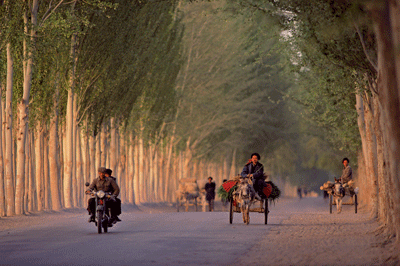
Two thousand years ago, the oasis of Khotan was an essential stop on the Silk Road, a meeting place and trading post for the caravans of China, India and Central Asia. Today, this city’s sense of time and culture remains a mix of East and West, of ancient history and modern reality.
Khotan – listed on maps alternatively as Hotan, Hetian, Yutian or even Ilchi – is no longer one of the largest cities in China’s Xinjiang Uyghur Autonomous Region. But it remains a crucial stop for anyone travelling through rugged and empty southern Xinjiang, where the main east-west highway still traces the old Silk Road. On one side of the city the Taklamakan Desert stretches off in a dun-coloured mirage, while to the south the snow-capped Kunlun Mountains loom.
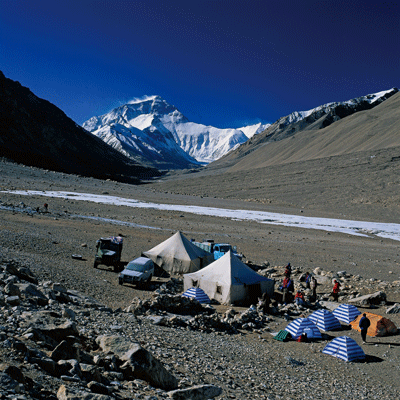
Khotan exists because of the Yurungkash and Karakash Rivers – or the White and Black Jade Rivers – which still irrigate the area’s extensive agriculture. Those watercourses, flowing from the mountains, create an oasis that has attracted parched travellers for centuries. They also held the jade that became famous across China for its beauty and quality. Travellers, and a handful of enterprising locals, still comb the riverbed, hoping to find bits of the precious stone.
The streets of Khotan are filled with produce from the nearby fields. Farmers cradling bright green melons in their arms, sheep brought to market by the flock, chased, bleating, along busy streets. Here, donkey-drawn carts still compete with cars.
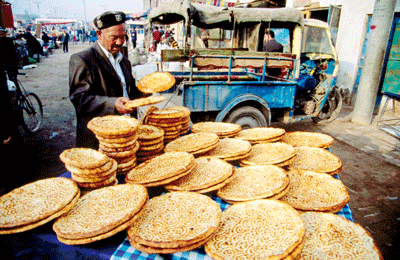
The sea of faces shows a mingling of Indian, Kazak and Chinese blood. Green eyes, strong noses and light coloured hair. The Central Asian and Indian influence in this ancient city is on display in the tapestries, tools and manuscripts at the Khotan Museum. Mummies, recovered from nearby archaeological sites, lie under glass and lights, illustrating Western China’s Caucasian history. This is where Islam has followed Buddhism and Zoroastrianism, each leaving their mark before giving way.
But the jade, the mummies and the rivers have difficulty competing with the allure of the bazaar. The market is where farmers and traders from small villages congregate. Men wearing giant sheepskin hats bark into mobile phones. Women are modestly wrapped head to toe in brilliant silks while teetering along muddy streets on high heels.
Age-old trading customs have been honed to perfection over centuries of bartering with goods that flowed into their market from across the desert. The men stand facing each other with broad smiles spread across their faces, grasping each other’s hands, palms up. They slap each other’s hands hard as they attempt to drive home a deal. “Ten yuan!” one man shouts, emphasising his offer with a sharp smack of his hand into his adversary’s palm. The seller responds with “15!” and an echoing clap. Negotiating tests a man’s mettle, and is carried out with the friendly rivalry of an arm wrestle.
The traders were dealing in everything from live caged pigeons and Band Aids by the dozen to woollen hats and chunks of fresh camel and horse meat, hanging bloody and fly-ridden in the street. One alley was overflowing with cheap mass-produced clothing, while the next contained rows of axes, knives and spades glinting in the sun. On one side of the street, a coal-peddler worked, his eyes shining out of a blackened face, and metres away a woman hawked steamed buns and pomegranate juice.
While I had ridden into the city from the east, saddle sore and red-eyed after thousands of kilometres of Chinese roads, most visitors to Khotan come from Kashgar, a day’s drive to the west. While the deeper cultural layers of Xinjiang came from the west, I was riding my motorcycle with the modern tide, running from east to west. Kashgar is more accessible than Khotan and one step closer to Urumqi, now home of the Han Chinese and the commercial heart of Xinjiang.
I drove the 500 kilometres of congested, speed-crazed traffic in a day, compared to the weeks this journey took traders in the early days. Each hour of riding brought me another century closer to the modern face of China. Shiny trucks barrelling down the road, laden with the product of distant factories and mines. The cars became sleeker, while the faces began to resemble those in the east more than those I’d seen in the desert.
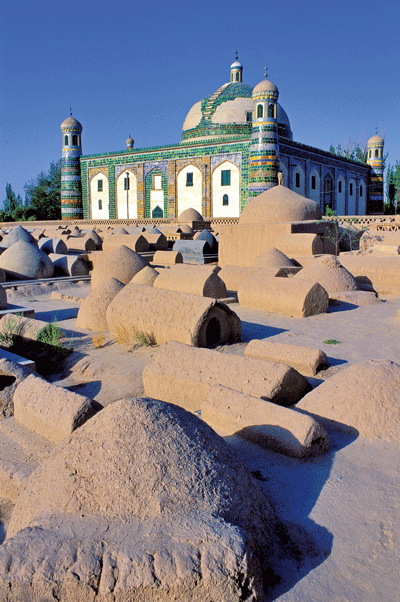
Kashgar is still a frontier city, perched on the far western border of China. But instead of a warren of mud-brick buildings and influence from Central Asia, it’s enjoying its first bloom of Chinese development. It has recently been designated as another Special Economic Zone, a Shenzhen of China’s far west, with neon lights, new cars, and cranes atop high-rise buildings. Motorbikes have been replaced by electric scooters, and KTV lounges trump tea houses.
Here my ear picks up snatches of Russian amid the more common Mandarin. Kashgar, more than Khotan, remains a trading centre for Uyghurs, Chinese, Kyrgyz, Tajiks and Uzbeks. It is a crossroads for traffic from Central Asia. From here the highways branch out to the north and south. The Karakoram Highway leads over the Himalayas, through Kashmir to Pakistan, creating the highest border crossing in the world.
But I’ve come to the end of my road. Kashgar is where I sell my motorcycle and walk the streets. The city has its own heaving bazaar, and nearby stands the Id Kah Mosque. Built in 1442, this is where the Chinese General Ma Zhancang displayed the severed head of Uyghur leader Timur Beg, who was shot to death, in 1933, making his point of Chinese domination.
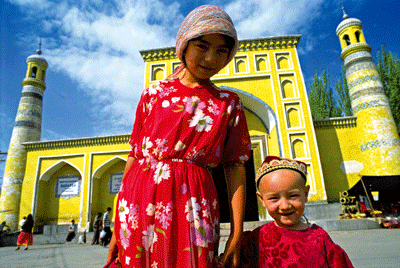
Little of Kashgar’s Old City remains, but what is there must be appreciated on foot. This was long considered one of Central Asia’s best-preserved examples of a traditional Islamic city, but in 2009, the Chinese government began bulldozing the ramshackle mud-brick maze, deeming it overcrowded and unsafe for residents. What’s left has been turned into a museum, complete with entry fees, although the homes are still inhabited.
The destruction continues, with a jumble of broken down walls spread around the small cluster of Old City that remains. Nearby stand gleaming new glass-and-steel buildings, a sign of China’s vision for the ancient city.
I flag down a taxi to return to my hotel. As he pulls away from the curb and into heavy traffic, he weaves around an old farmer, jouncing along on his donkey-drawn cart. I’ve seen where he came from, and I think I know where he’s going.
Traces of the Silk Road
Spread across the Taklamakan desert are the remains of ancient Buddhist cities that were built around oases thousands of years ago. Strange stories about cities buried by the shifting sands were passed on through the generations, and occasionally a traveller would stumble across such ruins, some even returning with the odd artefact. Even Hsuan-tsang, the seventh-century Buddhist pilgrim, wrote of a city that had succumbed to the sand after its inhabitants had failed to carry out their religious duties.
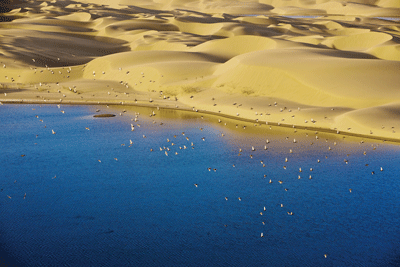
The lost cities of the Silk Road, such as Niya, Loulan and Turpan, were rediscovered by European adventurers and anthropologists in the late 1800s and early 1900s. Explorers such as Aurel Stein and Sven Hedin put a spotlight on Central Asia and the relics to be found at these sites. This was a new frontier for European exploration, and their discoveries sparked a race between museums to grab all the artefacts they could get their hands on. This became one of the greatest thefts of cultural property in history, a story best told by Peter Hopkirk in his book Foreign Devils on the Silk Road.
Manuscripts, paintings, statues and other relics were hauled out of China by the cart-load in the first few decades of the 20th century. Most of the artefacts went to Sweden, Britain, Germany, France, Japan and the US. The bulk of the treasure remains spread across museums in these countries to this day. However, the Chinese slammed the door on the looting before everything was gone, and in recent decades have excavated valuable mummies and artefacts from the desert sands.
Many modern cities along the Silk Road have constructed museums to display those pieces that were recovered or unearthed by the Chinese. The Caves of the Thousand Buddhas in Dunhuang and the Xinjiang Regional Museum in Urumqi are the two best places to learn about the ancient Buddhist cities in the desert.
Where to stay
Hotels outside of China’s main cities are strictly divided between those for foreigners and those for Chinese nationals. It is very difficult to rent a room in a domestic hotel if you are a foreigner. Hotels that welcome foreigners include:
Khotan: Yudu Hotel
+86 903 202 2888
Located just west of Tuanjie Square and next to the remnants of the old city wall.
Hotan Hotel
+86 903 251 3563
Islamic architecture and rose gardens give it a Central Asian feel.
Kashgar: Taxinan Barony Hotel
+86 998 258 6888
One of the more modern hotels, just across from the Old City.
Seman Hotel
+86 998 255 2861
Surrounded by tourism services, with rooms featuring carved wooden walls and beaded lampshades.
How to get there
Kashgar is connected by air with cities across China and Central Asia, through carriers such as China Southern (www.flychinasouthern.com). The most frequent flights arrive from Urumqi, from where you can also fly direct to Khotan. Alternatively, you can make the seven-hour drive from Kashgar to Khotan by bus or private car.








